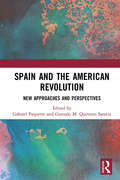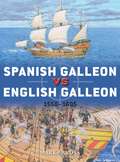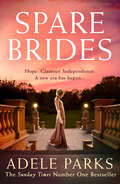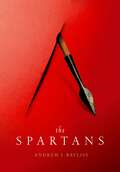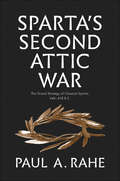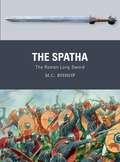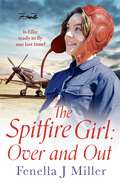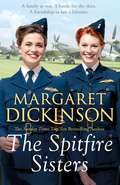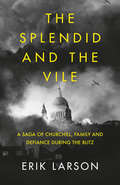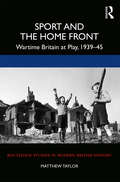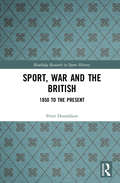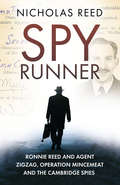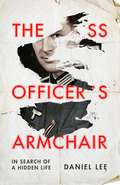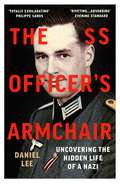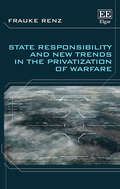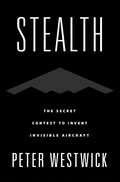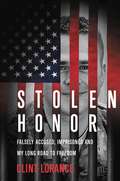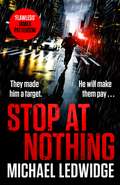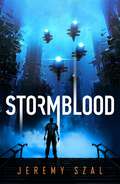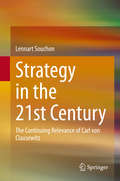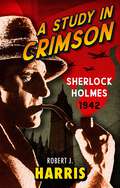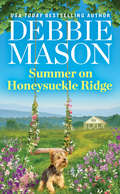- Table View
- List View
Spain and the American Revolution: New Approaches and Perspectives
by Gabriel Paquette Gonzalo M. Quintero SaraviaThough the participation of France in the American Revolution is well established in the historiography, the role of Spain, France’s ally, is relatively understudied and underappreciated. Spain's involvement in the conflict formed part of a global struggle between empires and directly influenced the outcome of the clash between Britain and its North American colonists. Following the establishment of American independence, the Spanish empire became one of the nascent republic's most significant neighbors and, often illicitly, trading partners. Bringing together essays from a range of well-regarded historians, this volume contributes significantly to the international history of the Age of Atlantic Revolutions.
Spain and the American Revolution: New Approaches and Perspectives
by Gabriel Paquette Gonzalo M. Quintero SaraviaThough the participation of France in the American Revolution is well established in the historiography, the role of Spain, France’s ally, is relatively understudied and underappreciated. Spain's involvement in the conflict formed part of a global struggle between empires and directly influenced the outcome of the clash between Britain and its North American colonists. Following the establishment of American independence, the Spanish empire became one of the nascent republic's most significant neighbors and, often illicitly, trading partners. Bringing together essays from a range of well-regarded historians, this volume contributes significantly to the international history of the Age of Atlantic Revolutions.
Spanish Galleon vs English Galleon: 1550–1605 (Duel #106)
by Mark LardasBetween 1550–1600, Europe witnessed a rapid evolution in the art of ship design which enabled safer and more efficient transatlantic travel. This was the pinnacle of the Age of Discovery and Exploration for the European powers, in which the galleon played a crucial role. Galleons were both the main vessels in maritime commerce and the principal warships used by the opposing fleets throughout the Age of Exploration. This period also saw a large amount of naval combat, much of it between individual ships belonging to the competing powers of England and Spain as they sought to control and exploit the rich mineral, material, agricultural and human resources of the New World. The conflict between the English Sea Dogs and the Spanish Adventurers has been a source of fascination for over four centuries. This exciting addition to the Duel series explores how the galleons used by Spain and England were built and armed, and examines the effectiveness of the cannon they used. It also compares how they were sailed and manoeuvred, showing the strengths and weaknesses of each design, and explaining how these played out in several of their most prominent battles, including the Battle of San Juan de Ulúa, the fight between the Golden Hind and the Nuestra Señora de la Concepción, an action from the Spanish Armada, and the last fight of the Revenge.
Spare Brides
by null Adele ParksHope. Glamour. Independence. A new era has begun… ‘A wonderfully absorbing tale of friendship, rich in period detail’ Stylist With the Great War behind them, four friends are ready to live again. Lydia, a society beauty, has everything – wealth, status and a husband who survived the War. All she has to do now is provide an heir. Widowed Sarah cares for her wounded brother, certain that no one will ever replace her brave husband. Younger sister Beatrice finds it hard to shine, especially when there are so few men left to shine for… And independent Ava – who can light any room – is determined to seize the freedom of being a single woman. But when these four meet the irresistible war hero Sergeant Major Edgar Trent, everything changes… Spare Brides is a glorious novel about love, loss, change and chances from the Number One bestselling author Adele Parks. Praise for Spare Brides: ‘A resounding success … a triumph’ Daily Mail ‘A touching novel’ Daily Express ‘You’ll love the drama, the gorgeous dresses, grand houses and in particular, the handsome but damaged love interest’ Good Housekeeping ‘This is the first historical novel from bestselling author Adele Parks and it’s a powerful read’ Closer ‘The great author’s first historical novel and it’s a total smash’ Heat ‘A wonderful novel about a group of women struggling to deal with life after World War One… a heady cocktail of love, class and beaded frocks. Her most accomplished novel yet’ Daisy Goodwin ‘A wonderfully absorbing tale of friendship, rich in period detail’ Stylist ‘A fantastic read’ Fabulous
The Spartans
by Andrew J. BaylissThe image of Sparta, and the Spartans, is one dyed indelibly into the public consciousness: musclebound soldiers with long hair and red cloaks, bearing shiny bronze shields emblazoned with the Greek letter lambda. 'This is Sparta!', bellows Leonidas on the silver screen, as he decides to lead his 300 warriors to their deaths at Thermopylae. But what was Sparta? The myths surrounding Sparta are as old as the city itself. Even in antiquity, Sparta was a unique society, considered an enigma. The Spartans who fought for freedom against the Persians called themselves 'equals' or peers, but their equality was reliant on the ruthless exploitation of the indigenous population known as helots. The Spartans' often bizarre rules and practices have the capacity to horrify as much they do to fascinate us today. Athenian writers were intrigued and appalled in equal measure by a society where weak or disabled babies were said to have been examined carefully by state officials before being dumped off the edge of a cliff. Even today their lurid stories have shaped our image of Sparta; a society in which cowards were forced to shave off half their beards, to dress differently from their peers, and who were ultimately shunned to the extent that suicide seemed preferable. Equally appalling to us today is the brutal krypteia, a Spartan rite of passage where teenagers were sent into the countryside armed with a knife and ordered to eliminate the biggest and most dangerous helots. But the truth behind these stories of the exotic other can be hard to discover, lost amongst the legend of Sparta which was even perpetuated by later Spartans, who ran a thriving tourist industry that exaggerated the famed brutality of their ancestors. As Andrew Bayliss explores in this book, there was also much to admire in ancient Sparta, such as the Spartans' state-run education system which catered even to girls, or the fact that Sparta was almost unparalleled in the pre-modern world in allowing women a clear voice, with no fewer than forty sayings by Spartan women preserved in our sources. This book reveals the best and the worst of the Spartans, separating myth from reality.
Sparta's Second Attic War: The Grand Strategy of Classical Sparta, 446-418 B.C. (Yale Library of Military History)
by Paul Anthony RaheIn a continuation of his multivolume series on ancient Sparta, Paul Rahe narrates the second stage in the six-decades-long, epic struggle between Sparta and Athens that first erupted some seventeen years after their joint victory in the Persian Wars. Rahe explores how and why open warfare between these two erstwhile allies broke out a second time, after they had negotiated an extended truce. He traces the course of the war that then took place, he examines and assesses the strategy each community pursued and the tactics adopted, and he explains how and why mutual exhaustion forced on these two powers yet another truce doomed to fail. At stake for each of the two peoples caught up in this enduring strategic rivalry, as Rahe shows, was nothing less than the survival of its political regime and of the peculiar way of life to which that regime gave rise.
The Spatha: The Roman Long Sword (Weapon #72)
by M.C. BishopAdopted from the Celts in the 1st century BC, the spatha, a lethal and formidable chopping blade, became the primary sword of the Roman soldier in the Later Empire. Over the following centuries, the blade, its scabbard, and its system of carriage underwent a series of developments, until by the 3rd century AD it was the universal sidearm of both infantry and cavalry. Thanks to its long reach, the spatha was the ideal cavalry weapon, replacing the long gladius hispaniensis in the later Republican period. As the manner in which Roman infantrymen fought evolved, styles of hand-to-hand combat changed so much that the gladius was superseded by the longer spatha during the 2nd century AD. Like the gladius, the spatha was technologically advanced, with a carefully controlled use of steel. Easy maintenance was key to its success and the spatha was designed to be easily repaired in the field where access to a forge may have been limited. It remained the main Roman sword into the Late Roman period and its influence survived into the Dark Ages with Byzantine, Carolingian and Viking blades. Drawing together historical accounts, excavated artefacts and the results of the latest scientific analyses of the blades, renowned authority M.C. Bishop reveals the full history of the development, technology, training and use of the spatha: the sword that defended an empire.
The Spitfire Girl: an emotional World War Two saga (The Spitfire Girl #4)
by Fenella J. MillerAll's fair in love and war for First Officer Ellie as she takes to the skies yet again in the final instalment of Fenella Miller's Spitfire Girl series. 1943, White Waltham. As Italy surrenders and victory looms on the horizon, Ellie's doing what she does best – flying. And this time, she's rising to the sky in four-engined Halifaxes. Determined to keep doing her bit, Ellie's successes in the airfield mount but so do tensions with her new beau, Squadron Leader Jack Reynolds. When Ellie and Jack find their dream home, they discover they've bought more than they bargained for. With a cellar full of secrets, Jack and Ellie must stand united in the face of mystery, war and loss. And as family circumstance threatens to tear them apart, Ellie and Jack are stronger than ever.
The Spitfire Sisters (The Maitland Trilogy)
by Margaret DickinsonFamily and friendship mean everything under the darkening skies of wartime Britain, by Sunday Times bestselling author Margaret Dickinson.It is the 1930s and the Maitland family have spent the years following the Great War struggling to come to terms with its catastrophic aftermath, and their hopes now lie with the next generation. Their Lincolnshire village of Doddington suffered terrible loss and it has taken great courage for the bereaved families to rebuild their lives without their loved ones.When war is declared again, it is Daisy Maitland and her peers who must now take up the fight for freedom. Feisty and a daredevil like her beloved Aunt Pips, who spent World War One on the front line serving with a flying ambulance corps, Daisy had persuaded a family friend to teach her to fly as a young woman. Now her country is at war, she is determined to put her skills to good use, enlisting in the Air Transport Auxiliary. There she forges new friendships – but she never forgets her childhood friend and cousin, Luke, who has joined the RAF as a fighter pilot.As war rages in the skies and on the ground, Daisy, her friends and her family – at home and across the Channel – will find their bravery and strength tested to the very limits in their determination to save their country. And they have learned one of the most valuable lessons of all: true love will find a way.
The Splendid and the Vile: A Saga Of Churchill, Family, And Defiance During The Blitz
by Erik LarsonTHE #1 NEW YORK TIMES BESTSELLER ‘There are countless books about World War II, but there’s only one Erik Larson … The book reads like a novel, and even though everyone (hopefully) knows how the war ultimately ended, he keeps the reader turning the pages with his gripping prose’ NPR
Sport and the Home Front: Wartime Britain at Play, 1939-45 (Routledge Studies in Modern British History)
by Matthew TaylorSport and the Home Front contributes in significant and original ways to our understanding of the social and cultural history of the Second World War. It explores the complex and contested treatment of sport in government policy, media representations and the everyday lives of wartime citizens. Acknowledged as a core component of British culture, sport was also frequently criticised, marginalised and downplayed, existing in a constant state of tension between notions of normality and exceptionality, routine and disruption, the everyday and the extraordinary. The author argues that sport played an important, yet hitherto neglected, role in maintaining the morale of the British people and providing a reassuring sense of familiarity at a time of mass anxiety and threat. Through the conflict, sport became increasingly regarded as characteristic of Britishness; a symbol of the ‘ordinary’ everyday lives in defence of which the war was being fought. Utilised to support the welfare of war workers, the entertainment of service personnel at home and abroad and the character formation of schoolchildren and young citizens, sport permeated wartime culture, contributing to new ways in which the British imagined the past, present and future. Using a wide range of personal and public records – from diary writing and club minute books to government archives – this book breaks new ground in both the history of the British home front and the history of sport.
Sport and the Home Front: Wartime Britain at Play, 1939-45 (Routledge Studies in Modern British History)
by Matthew TaylorSport and the Home Front contributes in significant and original ways to our understanding of the social and cultural history of the Second World War. It explores the complex and contested treatment of sport in government policy, media representations and the everyday lives of wartime citizens. Acknowledged as a core component of British culture, sport was also frequently criticised, marginalised and downplayed, existing in a constant state of tension between notions of normality and exceptionality, routine and disruption, the everyday and the extraordinary. The author argues that sport played an important, yet hitherto neglected, role in maintaining the morale of the British people and providing a reassuring sense of familiarity at a time of mass anxiety and threat. Through the conflict, sport became increasingly regarded as characteristic of Britishness; a symbol of the ‘ordinary’ everyday lives in defence of which the war was being fought. Utilised to support the welfare of war workers, the entertainment of service personnel at home and abroad and the character formation of schoolchildren and young citizens, sport permeated wartime culture, contributing to new ways in which the British imagined the past, present and future. Using a wide range of personal and public records – from diary writing and club minute books to government archives – this book breaks new ground in both the history of the British home front and the history of sport.
Sport, War and the British: 1850 to the Present (Routledge Research in Sports History)
by Peter DonaldsonSpanning the colonial campaigns of the Victorian age to the War on Terror after 9/11, this study explores the role sport was perceived to have played in the lives and work of military personnel, and examines how sporting language and imagery were deployed to shape and reconfigure civilian society’s understanding of conflict. From 1850 onwards war reportage – complemented and reinforced by a glut of campaign histories, memoirs, novels and films – helped create an imagined community in which sporting attributes and qualities were employed to give meaning and order to the chaos and misery of warfare. This work explores the evolution of the Victorian notion that playing-field and battlefield were connected and then moves on to investigate the challenges this belief faced in the twentieth century, as combat became, initially, industrialised in the age of total warfare and, subsequently, professionalised in the post-nuclear world. Such a longitudinal study allows, for the first time, new light to be shed on the continuities and shifts in the way the ‘reality’ of war was captured in the British popular imagination. Drawing together the disparate fields of sport and warfare, this book serves as a vital point of reference for anyone with an interest in the cultural, social or military history of modern Britain.
Sport, War and the British: 1850 to the Present (Routledge Research in Sports History)
by Peter DonaldsonSpanning the colonial campaigns of the Victorian age to the War on Terror after 9/11, this study explores the role sport was perceived to have played in the lives and work of military personnel, and examines how sporting language and imagery were deployed to shape and reconfigure civilian society’s understanding of conflict. From 1850 onwards war reportage – complemented and reinforced by a glut of campaign histories, memoirs, novels and films – helped create an imagined community in which sporting attributes and qualities were employed to give meaning and order to the chaos and misery of warfare. This work explores the evolution of the Victorian notion that playing-field and battlefield were connected and then moves on to investigate the challenges this belief faced in the twentieth century, as combat became, initially, industrialised in the age of total warfare and, subsequently, professionalised in the post-nuclear world. Such a longitudinal study allows, for the first time, new light to be shed on the continuities and shifts in the way the ‘reality’ of war was captured in the British popular imagination. Drawing together the disparate fields of sport and warfare, this book serves as a vital point of reference for anyone with an interest in the cultural, social or military history of modern Britain.
Spy Runner: Ronnie Reed and Agent Zigzag, Operation Mincemeat and the Cambridge Spies
by Nicholas ReedMost of us remember the seventh of September 1940 as the day the London docks were bombed and devastated by fire. I remember it as the day I was called up. But the police car that collected me took me to Wormwood Scrubs Prison . . . Major Ronnie Reed never spoke about what he did in the Second World War. He was only 23 when it broke out; an amateur radio enthusiast who was working as a maintenance engineer for the BBC. And yet, despite minimal money and qualifications, he became one of the men behind some of the most remarkable spy stories of all time. Recruited in the dead of night from his Anderson shelter, Ronnie became a case officer for double agents, including Eddie Chapman, known then as Agent Zigzag. The passport photo of The Man Who Never Was, was a photo of Ronnie Reed. For ten years after the Second World War, he headed the anti-Russian department of MI5, dealing with notorious spies such as Philby, Burgess and Maclean. In 1994, shortly before Ronnie’s death, he revealed the truth of his remarkable past to his son, Nicholas. In Spy Runner he reveals his father’s fascinating story with a collection of recently released reports and photos from The National Archives, and intimate family snaps.
The SS Officer's Armchair: In Search of a Hidden Life
by Daniel LeeIt began with an armchair. It began with the surprise discovery of a stash of personal documents covered in swastikas sewn into its cushion. The SS Officer’s Armchair is the story of what happened next, as Daniel Lee follows the trail of cold calls, documents, coincidences and family secrets, to uncover the life of one Dr Robert Griesinger from Stuttgart. Who was he? What had his life been – and how had it ended?Lee reveals the strange life of a man whose ambition propelled him to become part of the Nazi machinery of terror. He discovers his unexpected ancestral roots, untold stories of SS life and family fragmentation. As Lee delves deeper, Griesinger’s responsibility as an active participant in Nazi crimes becomes clearer. Dr Robert Griesinger’s name is not infamous. But to understand the inner workings of the Third Reich, we need to know not just its leaders, but the ordinary Nazis who made up its ranks. Revealing how Griesinger’s choices reverberate into present-day Germany, and among descendants of perpetrators, Lee raises potent questions about blame, manipulation and responsibility. A historical detective story and a gripping account of one historian’s hunt for answers, The SS Officer’s Armchair is at once a unique addition to our understanding of Nazi Germany and a chilling reminder of how such regimes are made not by monsters, but by ordinary people.
The SS Officer's Armchair: In Search of a Hidden Life
by Daniel LeeIt began with an armchair. It began with the surprise discovery of a stash of personal documents covered in swastikas sewn into its cushion. The SS Officer’s Armchair is the story of what happened next, as Daniel Lee follows the trail of cold calls, documents, coincidences and family secrets, to uncover the life of one Dr Robert Griesinger from Stuttgart. Who was he? What had his life been – and how had it ended?Lee reveals the strange life of a man whose ambition propelled him to become part of the Nazi machinery of terror. He discovers his unexpected ancestral roots, untold stories of SS life and family fragmentation. As Lee delves deeper, Griesinger’s responsibility as an active participant in Nazi crimes becomes clearer. Dr Robert Griesinger’s name is not infamous. But to understand the inner workings of the Third Reich, we need to know not just its leaders, but the ordinary Nazis who made up its ranks. Revealing how Griesinger’s choices reverberate into present-day Germany, and among descendants of perpetrators, Lee raises potent questions about blame, manipulation and responsibility. A historical detective story and a gripping account of one historian’s hunt for answers, The SS Officer’s Armchair is at once a unique addition to our understanding of Nazi Germany and a chilling reminder of how such regimes are made not by monsters, but by ordinary people.
State Responsibility and New Trends in the Privatization of Warfare
by Frauke RenzContracts with private military and security companies are a reality of modern conflicts. This discerning book provides nuanced insights into the international legal implications of these contracts, and establishes an in-depth understanding of the impacts for contracting states, home states and territorial states under the current state responsibility regime. Focussing on the Articles on State Responsibility (ASR) the author considers under which conditions states are, or should be, responsible for the acts of private contractors given new trends towards remote warfare involving drones and increasingly autonomous weapon systems. Rigorous academic research and case studies, combined with insights from numerous interviews with practitioners, serve to highlight the challenges to applying the ASR. These challenges range from the relativity of key concepts of attribution to the issue of when reliance on private contractors becomes a violation of the principle of distinction under International Humanitarian Law and also illustrate where the current state responsibility regime needs to be modified to adequately address evolutions in warfare. This astute and incisive book will prove a key resource for legal scholars and theorists with an interest in public international law, IHL and IHRL. Government officials, practitioners and think tanks engaged in compliance matters and new trends in warfare will also benefit from this work’s pragmatic approach.
Stealth: The Secret Contest to Invent Invisible Aircraft
by Peter WestwickOn a moonless night in January 1991, a dozen U.S. aircraft appeared in the skies over Baghdad. To the Iraqi air defenses, the planes seemed to come from nowhere. Their angular shape, making them look like flying origami, rendered them virtually undetectable. Each aircraft was more than 60 feet in length and with a wingspan of 40 feet, yet its radar footprint was the size of a ball bearing. Here was the first extensive combat application of Stealth technology. And it was devastating. Peter Westwick's new book illuminates the story behind these aircraft, the F-117A, also known as the Stealth Fighter, and their close cousin the B-2, also known as the Stealth Bomber. The development of Stealth unfolded over decades. Radar has been in use since the 1930s and was essential to the Allies in World War Two, when American investment in radar exceeded that in the Manhattan Project. The atom bomb ended the war, conventional wisdom has it, but radar won it. That experience also raised a question: could a plane be developed that was invisible to radar? That question, and the seemingly impossible feat of physics and engineering behind it, took on increasing urgency during the Cold War, when the United States searched for a way both to defend its airspace and send a plane through Soviet skies undetected. Thus started the race for Stealth. At heart, Stealth is a tale of not just two aircraft but the two aerospace companies that made them, Lockheed and Northrop, guided by contrasting philosophies and outsized personalities. Beginning in the 1970s, the two firms entered into a fierce competition, one with high financial stakes and conducted at the highest levels of secrecy in the Cold War. They approached the problem of Stealth from different perspectives, one that pitted aeronautical designers against electrical engineers, those who relied on intuition against those who pursued computer algorithms. The two different approaches manifested in two very different solutions to Stealth, clearly evident in the aircraft themselves: the F-117 composed of flat facets, the B-2 of curves. For all their differences, Lockheed and Northrop were located twenty miles apart in the aerospace suburbs of Los Angeles, not far from Disneyland. This was no coincidence. The creative culture of postwar Southern California-unorthodox, ambitious, and future-oriented-played a key role in Stealth. Combining nail-biting narrative, incisive explanation of the science and technology involved, and indelible portraits of unforgettable characters, Stealth immerses readers in the story of an innovation with revolutionary implications for modern warfare.
Stolen Honor: Falsely Accused, Imprisoned, and My Long Road to Freedom
by Clint LoranceThe captivating account of how Clint Lorance, a soldier who became a scapegoat for a corrupt military hierarchy, was falsely charged with war crimes, imprisoned, and eventually pardoned by President Trump. While out on patrol in Afghanistan, Clint Lorance learned that two men, both suspected suicide bombers, were speeding toward a crowded city on motorcycles. Lorance couldn't see them, but his men on the ground had clear shots. After a split second, he gave the order to shoot, killing both men. In the months that followed, Lorance was arrested by the military and put on trial for war crimes. Prosecutors claimed that the order he gave constituted an act of premeditated murder, and they sentenced him to twenty years in prison. In Stolen Honor, Lorance finally tells the story of this event and the trial it led to -- how the prosecutors declined to admit clear-cut evidence that would have exonerated him, how the men in his unit turned on him, and why he still believes he was right to give the order to shoot. It is a story that stretches from small-town America to the deserts of Afghanistan, from the White House to the tiny jail cell where Lorance spent six years waiting on his exoneration, which finally came when President Trump pardoned him in 2019. The book also discusses Lorance's plans to attend law school and help reform the broken military justice system.
Stop At Nothing: the explosive new thriller James Patterson calls 'flawless'
by Michael LedwidgeTHEY MADE HIM A TARGET. HE'LL MAKE THEM PAY.'FLAWLESS...Michael Ledwidge has the gift.' James Patterson, world's bestselling author.When a private jet crashes into the Caribbean sea, diving instructor Michael Gannon is the only person on the scene. Finding six dead men and a suitcase full of cash and diamonds, Gannon assumes he's the beneficiary of a drug deal gone wrong.However, it seems one of the passengers was the Director of the FBI - despite the official story that he died of natural causes in Italy. Suddenly pursued by a shadowy cabal of the world's most powerful and dangerous men, Gannon will only survive if he unravels a terrifying conspiracy.But those determined to kill him will learn that Gannon's past holds its own deadly secrets...and the hunters soon become the prey.One man will stop at nothing to survive in this pulse-racing thriller that will grip fans of Lee Child, David Baldacci, James Patterson and Gregg Hurwitz.
Stormblood
by Jeremy SzalVakov Fukasawa used to be a Reaper: a bio-enhanced soldier fighting for the Harmony, against a brutal invading empire. He's still fighting now, on a different battlefield: taking on stormtech. To make him a perfect soldier, Harmony injected him with the DNA of an extinct alien race, altering his body chemistry and leaving him permanently addicted to adrenaline and aggression. But although they meant to create soldiers, at the same time Harmony created a new drug market that has millions hopelessly addicted to their own body chemistry. Vakov may have walked away from Harmony, but they still know where to find him, and his former Reaper colleagues are being murdered by someone, or something - and Vakov is appalled to learn his estranged brother is involved. Suddenly it's an investigation he can't turn down . . . but the closer he comes to the truth, the more addicted to stormtech he becomes.And it's possible the war isn't over, after all . . .
Strategy in the 21st Century: The Continuing Relevance of Carl von Clausewitz
by Lennart SouchonThis book presents a detailed discussion of Clausewitz's principal lines of thought and methods of implementation. It elaborates on his main objective of laying a foundation for the education of up-and-coming creative, knowledgeable and experienced future leaders. The book encourages reflection and study in strategic thinking in order to transform knowledge into genuine capability. The book explores the question of what a twenty-first-century decision-maker can learn from these strategic lines of thought. It bridges the gap between philosophical theory and strategic interaction in conflicts with an equal opponent. Readers learn to understand and employ the clash of wills, attack and defence, and friction, and in essence the necessary virtues of a strategic commander.The findings presented help to identify the essential features in complex decision-making situations and developing possible courses of strategic action from a holistic standpoint. As such, the book is a must read for strategists, business practitioners, and scholars of political leadership and management interested in a better understanding of strategy and decision-making.
A Study in Crimson: Sherlock Holmes: 1942
by Robert J. HarrisA killer going by the name of 'Crimson Jack' is stalking the wartime streets of London, murdering women on the exact dates of the infamous Jack the Ripper killings of 1888. Has the Ripper somehow returned from the grave? Is the selfstyled Crimson Jack a descendant of the original Jack or merely a madman obsessed with those notorious killings?In desperation Scotland Yard turn to Sherlock Holmes, the world’s greatest detective. Surely he is the one man who can sift fact from legend and track down Crimson Jack before he completes his tally of death. As Holmes and the faithful Watson tread the blacked out streets of London, death waits just around the corner.
Summer on Honeysuckle Ridge (Highland Falls #1)
by Debbie MasonSparks fly between an L.A. career woman and a former Army Ranger in this delightful enemies-to-lovers romance from the USA Today bestselling queen of small-town love stories.Welcome to Highland Falls, a small town where love is always in the air.In just a few months Abby Everhart has gone from being a top LA media influencer to an unemployed divorcée living out of her car. So inheriting her great-aunt's homestead comes at the perfect time. Abby heads to Highland Falls, North Carolina, to spruce up Honeysuckle Farm before putting it on the market for some much-needed cash. But instead of finding a charming getaway, she discovers a serious fixer-upper, complete with a leaky roof, overgrown yard, and a reclusive -- albeit sexy -- man living on the property.Ex-Delta Force soldier Hunter MacKenzie has faced war and loss, but nothing has quite prepared him for an outgoing redhead who's determined to turn his life upside down. Hunter doesn't want to get involved with anyone, especially a city girl who plans to sell the only place he's ever felt at home. But the sparks between them are undeniable. Spending time with Abby is easy. Convincing her to stay for good is another matter entirely.
